Every musician has a repertoire, but how do you maintain a multitude of pieces? Let’s learn how to add 48 pieces of music to your repertoire and remember them.
If you are a musician then you know the importance of keeping a maintaining your repertoire. Undoubtedly, being able to pull a piece out of memory at a moment’s notice is a great skill to have. Moreover, you can amuse and impress your friends and family with short recitals. Then they will ask you to play Wonderwall or whatever the worldwide music machine says is cool this week. But I digress.
What if I tell you that you could learn, keep, and play 48 pieces from memory? Would that interest you? I hear you say, “Yeah, right, Mr. Pauly guitar man, what’s the catch?” Well, the catch my guitar-centric tuned friend is: that you must have a plan. And then you must work out the plan. It really is that simple. Most of life is that simple. You have a goal. Make a plan. Work the plan. Achieve the goal.

The Goal
The goal is simple: to have a large repertoire of memorized pieces that you can call up at any time. The first step is to memorize the piece. You must go about the process of entering the information for recall. Okay, I realize that sounds obvious, but bear with me for a moment. There are several approaches to memorizing a piece of music. You could start from the beginning (which is a good place to start). Additionally, you could memorize measure by measure. You could memorize one or two lines or phrases a night. Conversely, you could start at the end of the piece and memorize bar by bar backward.
You could start in the middle section and memorize it first. Or you could memorize a phrase, get it up to speed, and then move on to the next phrase. You could try to mix these ideas. Start a phrase by memorizing it backward (starting with the last measure of the phrase). Memorize the phrase by playing the chords. Try different approaches and see what works best for you.
Okay, that is all the memorization strategies I can think of. Oh, by the way, you will do this one piece at a time.
Review the Repertoire
As you memorize pieces and get them “under your fingers,” add them to your repertoire list. Most musicians reading this will already have several pieces in their repertoire. Again, bear with me as we start from scratch.
Now we need to create a list of memorized pieces. I recommend a six-day weekly practice schedule. You will practice four pieces per day (after you fill in all the slots). The first slot is for the new piece you are working on, named Piece A, which goes in the New Piece slot.

Once Piece A is learned and committed to memory. Move it down to Piece in Review and start a new New Piece (Piece B):

Piece in Review
Play the Piece in Review every day as you are learning the new Piece B. This will solidify Piece A “under your fingers.” Once you have learned Piece B, it moves to the Piece in Review slot, and Piece A moves into the first slot on Monday of Weekly Repertoire. At this point Piece A should be stable in your memory. All you need to do is keep it in review. You then add a new piece, Piece C to the New Piece slot.
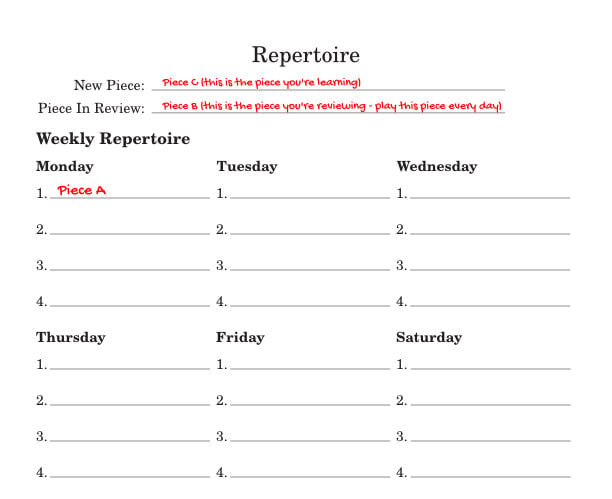
Once you have learned Piece C, it moves to the Piece in Review slot, and Piece B moves into the first slot on Monday of the Weekly Repertoire. Piece A moves to the Tuesday slot of the Weekly Repertoire. At this point, Piece B should be stable in your memory. All you need to do is keep it in review. You then add a new piece, Piece D to the New Piece slot.
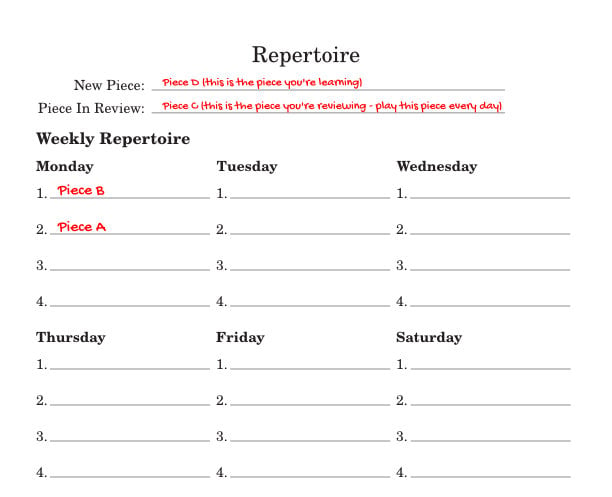
Wash, rinse, and repeat until you have all four slots on Monday full.
Tuesday’s Song
Once you have learned enough pieces to fill all of Monday’s slots, Piece A will move to Tuesday’s slot 1:
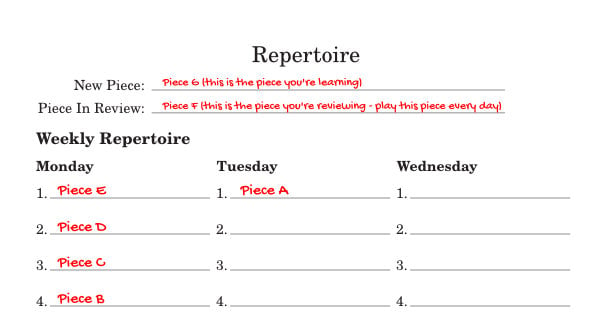
By the way, congratulations. You now have 6 pieces memorized and are working on the seventh. You are well on your way to the 48 pieces. Keep going. This is going to take time.
Fill in the Weekly Repertoire
Continue the process until all 24 slots in the Weekly Repertoire section are filled. At this point, you will have 25 pieces memorized. That is 4 for each day and one in review:
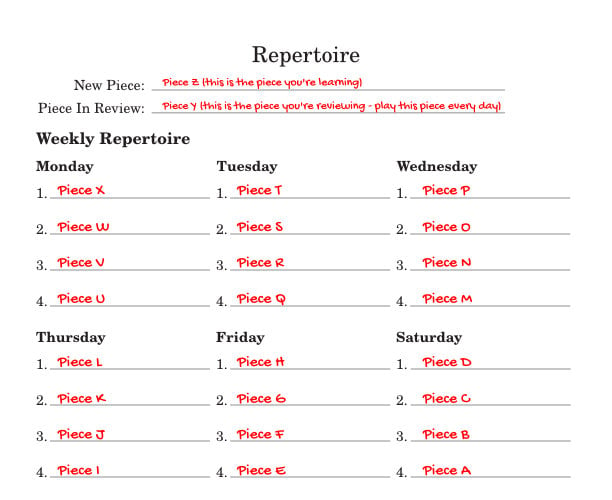
But wait there is still more. Once the Weekly Repertoire slots are filled, we start moving pieces to the Monthly Repertoire.
Monthly Repertoire
At this point, Piece A, the original piece you started with, should be pretty much ingrained into your being. Now you are learning a new piece, the illustrious Piece AA by the ultra-famous Mr. Anonymous. Piece A now moves into the Monthly Repertoire. Now on the first Monday of every month, you will play 5 pieces during your repertoire practice time:
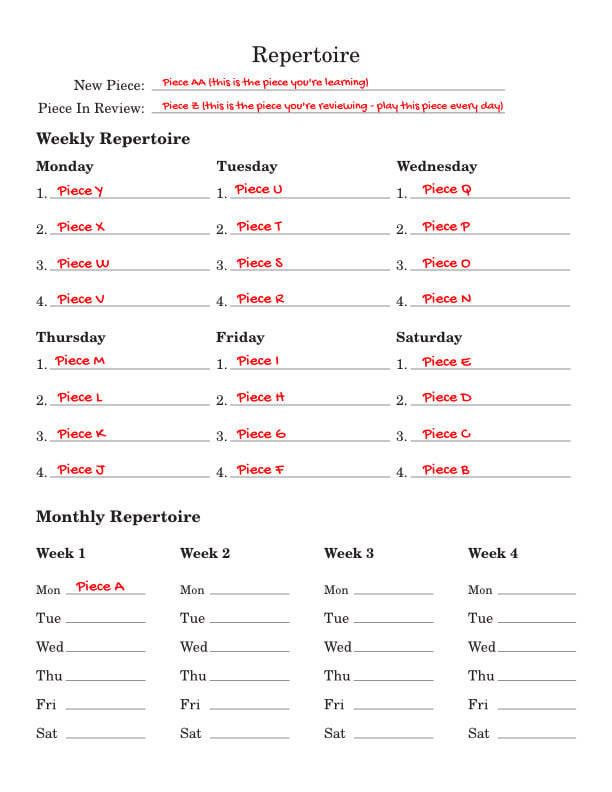
As you continue to learn and add pieces, move them down a slot each time. When you fill up the slots in the Monthly Repertoire you will have 48 pieces in your memory. Cool, huh?
You can download a free copy of the Monthly Repertoire Sheet here.
Final Thoughts
Here are a few final thoughts. This idea was inspired by Sean Beavers and his How to Improve on Classical Guitar Livestream. The Livestream is broadcast every Monday at 1 p.m. Remember that this will take time to build as you add pieces to your repertoire. To do this you will have to be committed to the process. As you build your repertoire and fill all the slots, you can start dropping easier pieces. This means earlier beginner pieces that you probably would not play publicly. However, until then, I would keep every piece just for practice.
If you like this blog post, you should sign up for the monthly newsletter and consider sharing it.




Comments ()